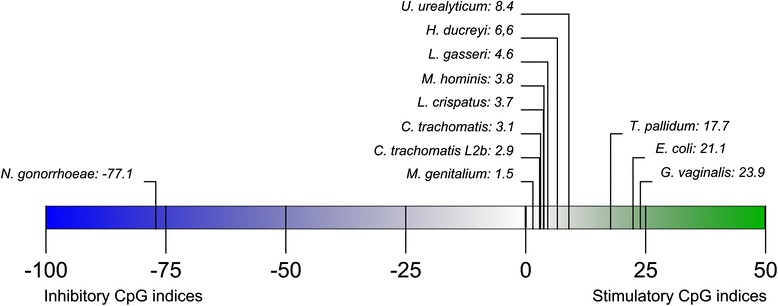CpG DNA analysis of bacterial STDs
- PMID: 26179610
- PMCID: PMC4504089
- DOI: 10.1186/s12879-015-1016-7
CpG DNA analysis of bacterial STDs
Abstract
Background: Bacterial infections in the genital tract frequently result in morbidity through a variety of inflammation based symptoms. One component of the bacteria that may trigger host inflammatory response is their DNA. CpG motifs in this DNA are known targets for Toll-like receptor 9 (TLR9), which is a pathogen-recognition receptors focusing on CpG DNA. The activation of TLR9 induces the NF-κB inflammatory pathway. This study aims to provide a broad view of the inflammatory potential of CpG DNA motifs in bacteria related to genital diseases: C. trachomatis, E. coli, N. gonorrhoeae, G. vaginalis, H. ducreyi, L. crispatus, L. gasseri, M. hominis, M. genitalium, T. pallidum, and U. urealyticum.
Methods: Publicly available genomic sequences of the bacterial species and strains have been analyzed in silico to produce a CpG index number. This CpG index number shows the relative inflammatory potential of the genome and has previously been used in a study by Lundberg et al. (2003). Higher CpG index values suggest a strong CpG induced inflammation potential during infection and vice versa.
Results: The highest observed CpG index belongs to G. vaginalis with a value of 26,2, suggesting a strong pro-inflammatory potential when in contact with TLR9. The lowest index belongs to N. gonorrhoeae with a value of -79,5, suggesting a strong immunoinhibitory effect on TLR9 contact. Interestingly, Lactobacilli showed a mean CpG index value of 4,2, suggesting a weak inflammatory potential.
Discussion: Our results show varying CpG index values between bacterial species. Comparison of CpG indices with the clinical course of several pathogens shows the CpG index helps clarify the clinical course of infection. However, we found no links between CpG index values and either obligate pathogenicity or facultative pathogenicity through bacterial vaginosis. Lactobacilli showed relatively low CpG indices which do suggest a lower inflammatory potential from these bacteria.
Conclusions: Our results show varying CpG index values between bacterial species, which may help clarify the clinical course of infection, and may help diagnosis.
Figures
Similar articles
-
Gardnerella vaginalis and Mollicute detection in rectal swabs from men who have sex with men.Int J STD AIDS. 2017 Jun;28(7):708-714. doi: 10.1177/0956462416665060. Epub 2016 Aug 19. Int J STD AIDS. 2017. PMID: 27542698
-
Host-Pathogen Interactions during Female Genital Tract Infections.Trends Microbiol. 2019 Dec;27(12):982-996. doi: 10.1016/j.tim.2019.07.006. Epub 2019 Aug 23. Trends Microbiol. 2019. PMID: 31451347 Review.
-
Selectivity of Human TLR9 for Double CpG Motifs and Implications for the Recognition of Genomic DNA.J Immunol. 2017 Mar 1;198(5):2093-2104. doi: 10.4049/jimmunol.1600757. Epub 2017 Jan 23. J Immunol. 2017. PMID: 28115525
-
[Microbiologic basis of diagnosis and treatment of pelvic inflammatory disease].J Gynecol Obstet Biol Reprod (Paris). 2012 Dec;41(8):850-63. doi: 10.1016/j.jgyn.2012.09.015. Epub 2012 Nov 8. J Gynecol Obstet Biol Reprod (Paris). 2012. PMID: 23140621 Review. French.
-
Prevalence of Mycoplasma genitalium and other sexually transmitted infections causing urethritis among high-risk heterosexual male patients in Estonia.Infect Dis (Lond). 2018 Feb;50(2):133-139. doi: 10.1080/23744235.2017.1366044. Epub 2017 Sep 4. Infect Dis (Lond). 2018. PMID: 28868962
Cited by
-
A case of deep vein thrombosis associated with methicillin sensitive Staphylococcal aureus genu septic arthritis.Infect Dis Rep. 2020 Jul 6;12(Suppl 1):8725. doi: 10.4081/idr.2020.8725. eCollection 2020 Jul 7. Infect Dis Rep. 2020. PMID: 32874457 Free PMC article.
-
Neutrophils: Beneficial and Harmful Cells in Septic Arthritis.Int J Mol Sci. 2018 Feb 5;19(2):468. doi: 10.3390/ijms19020468. Int J Mol Sci. 2018. PMID: 29401737 Free PMC article. Review.
-
Role of immunostimulatory deoxycytidylate-phosphate-deoxyguanylate (CpG) motifs in oral bacteria associated with oral diseases.J Oral Microbiol. 2025 Apr 7;17(1):2486639. doi: 10.1080/20002297.2025.2486639. eCollection 2025. J Oral Microbiol. 2025. PMID: 40213770 Free PMC article.
-
Loss of DNA methylation in zebrafish embryos activates retrotransposons to trigger antiviral signaling.Development. 2017 Aug 15;144(16):2925-2939. doi: 10.1242/dev.147629. Epub 2017 Jul 11. Development. 2017. PMID: 28698226 Free PMC article.
-
Recognition of Chlamydia trachomatis by Toll-like receptor 9 is altered during persistence.Infect Immun. 2024 Jul 11;92(7):e0006324. doi: 10.1128/iai.00063-24. Epub 2024 Jun 20. Infect Immun. 2024. PMID: 38899879 Free PMC article.
References
MeSH terms
Substances
LinkOut - more resources
Full Text Sources
Other Literature Sources
Medical
Molecular Biology Databases


